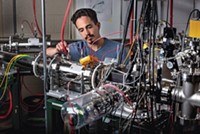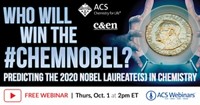Advertisement
Grab your lab coat. Let's get started
Welcome!
Welcome!
Create an account below to get 6 C&EN articles per month, receive newsletters and more - all free.
It seems this is your first time logging in online. Please enter the following information to continue.
As an ACS member you automatically get access to this site. All we need is few more details to create your reading experience.
Not you? Sign in with a different account.
Not you? Sign in with a different account.
ERROR 1
ERROR 1
ERROR 2
ERROR 2
ERROR 2
ERROR 2
ERROR 2
Password and Confirm password must match.
If you have an ACS member number, please enter it here so we can link this account to your membership. (optional)
ERROR 2
ACS values your privacy. By submitting your information, you are gaining access to C&EN and subscribing to our weekly newsletter. We use the information you provide to make your reading experience better, and we will never sell your data to third party members.
Physical Chemistry
Collider Ramps Up
World's largest particle accelerator sends its first protons flying
by Sarah Everts
September 15, 2008
| A version of this story appeared in
Volume 86, Issue 37

EARLY ON SEPT. 10, protons made their maiden voyage around the Large Hadron Collider (LHC), the world's newest and most powerful particle accelerator, located near Geneva.
The successful launch of the European Organization for Nuclear Research's multi-billion-dollar project is a "critical milestone, and of course we are all excited about it," says Columbia University physicist Michael Tuts, who led the U.S. team involved in designing one of the accelerator's four detectors.
"But for those of us involved in doing the experiments, the real excitement will be when the first experimental collisions occur, because that's when we will start to see data," Tuts adds.
The goal of the launch was to ensure protons could be directed by superconducting magnets around the 27-km (about 16-mile) underground track. When the LHC is working at full potential, it will collide two beams of protons, each traveling in opposite directions at energies of 7×1012 eV. The LHC will be seven times more powerful than the Tevatron at Fermi National Accelerator Laboratory, the world's next-biggest accelerator, in Batavia, Ill.

The LHC aims to resolve some fundamental physics conundrums, such as the makeup of dark matter and whether the Higgs boson exists. Many theoreticians think that the latter particle led to the origin of mass in the moments after the Big Bang.
"Finding one or more Higgs bosons would be of enormous importance," says Jonathan Lewis, a physicist at Fermi. Mass is believed to originate from the strength of the coupling of a given particle to the Higgs field, which emanates from a Higgs boson, he explains. But so far, nobody has been able to detect one.
If the LHC doesn't discover one or more Higgs bosons, physicists may have to start from scratch if they want to explain the origin of mass, Tuts says.
The LHC could also provide evidence for the extra dimensions proposed by string theory, an emerging mathematical model of the universe. For example, if energy appears to be missing after a collision, it may be that some of the particles have gone into one of the 10 or 11 dimensions predicted by the theory, Tuts notes.
"People talk about string theory, but we have no experimental evidence for it," Tuts says. "The LHC could truly revolutionize physics."





Join the conversation
Contact the reporter
Submit a Letter to the Editor for publication
Engage with us on Twitter